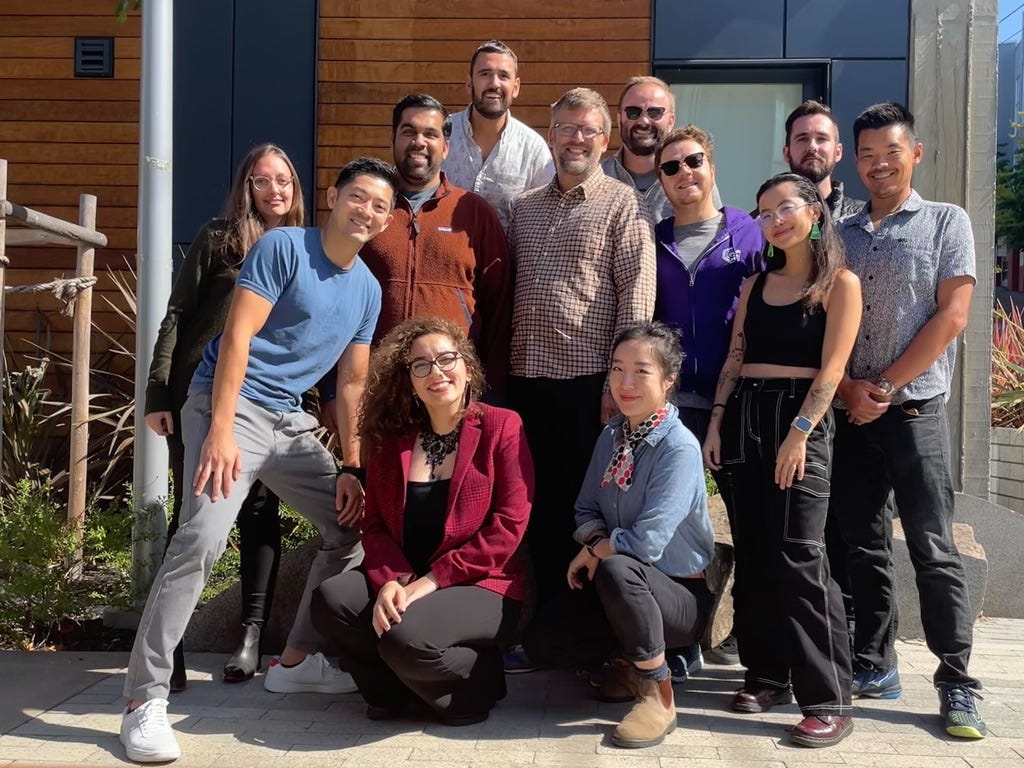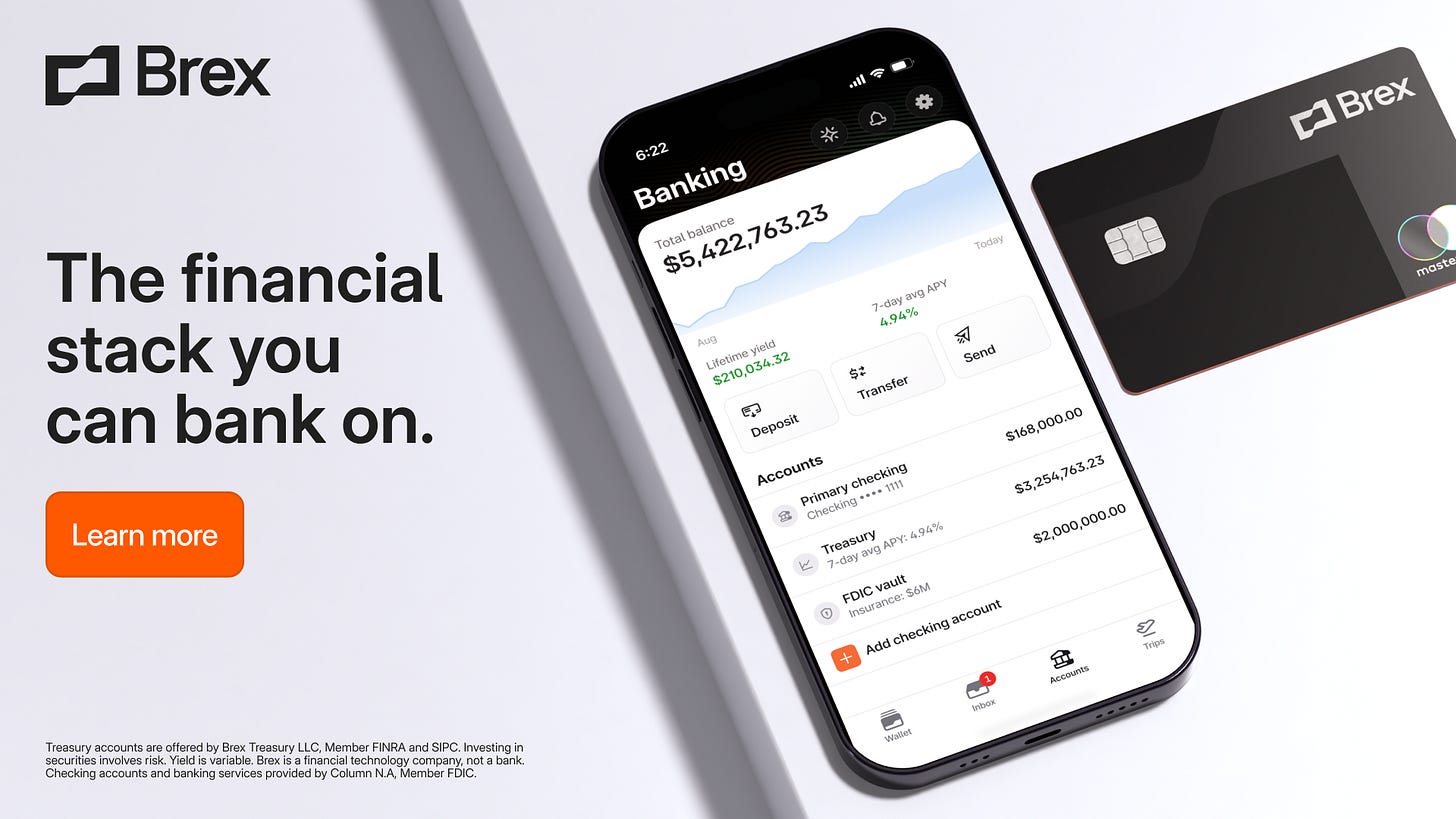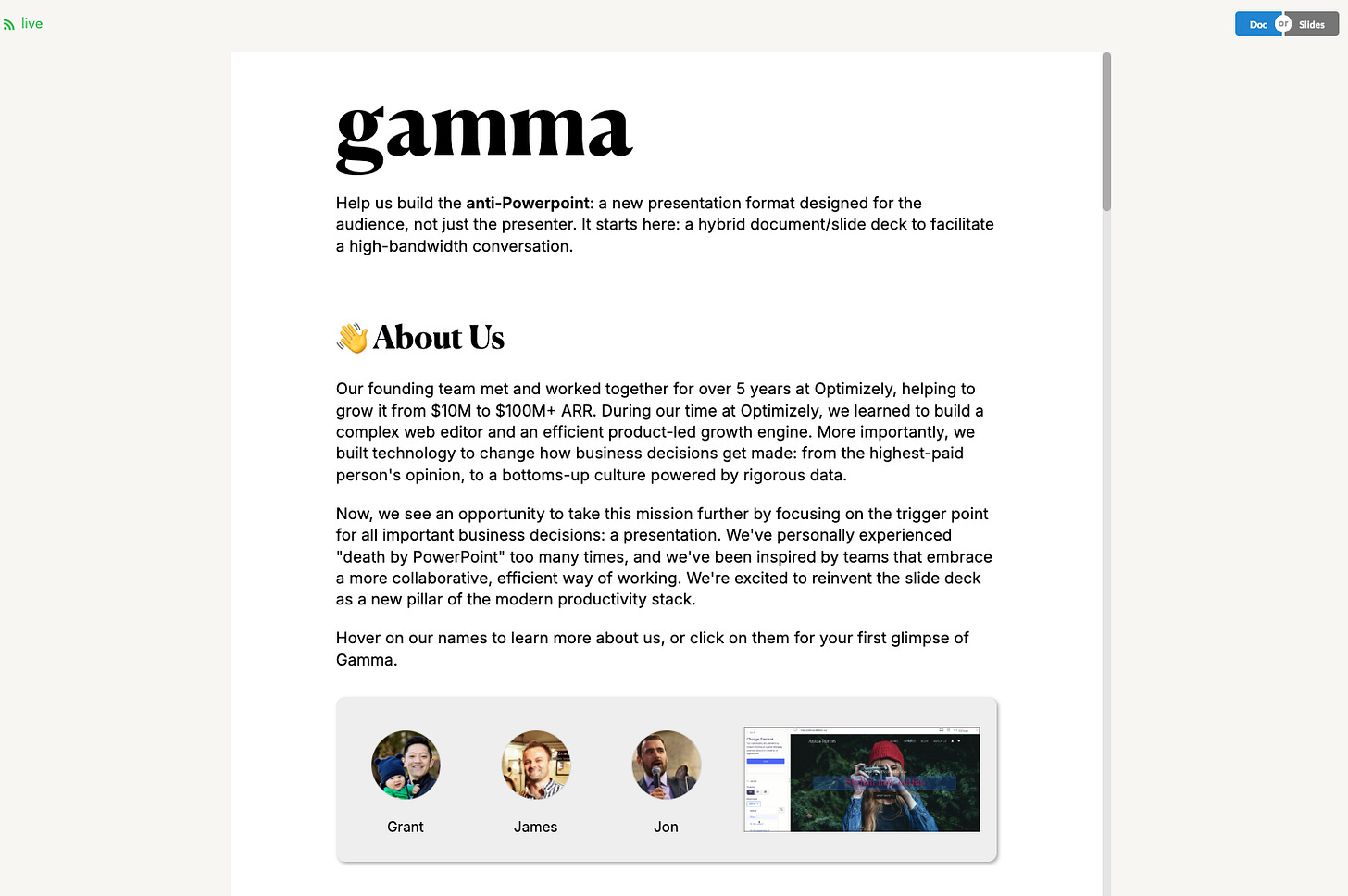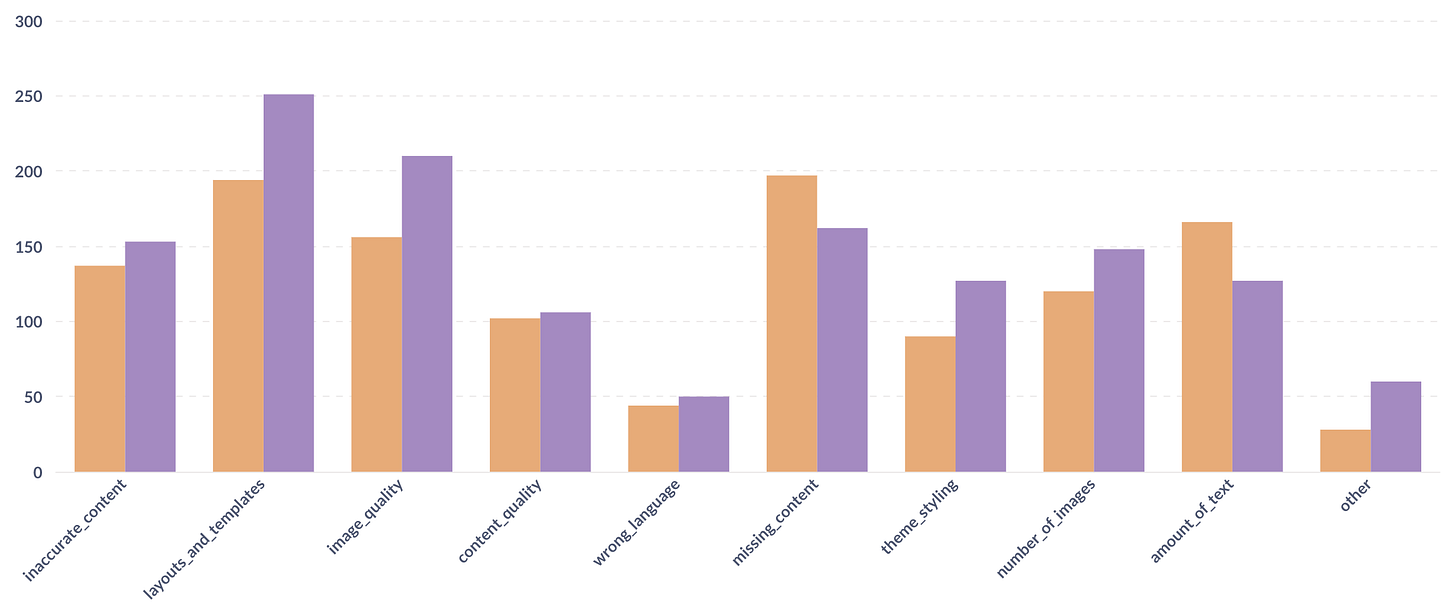Meet Gamma, A Low-Profile AI Startup That’s Actually Profitable
AI startup CEO Grant Lee has turned obsessive A/B testing – and a healthy distrust of venture capital – into 50 million in ARR and profits to go with 50 million users. Plus: Upstarts is on the road.

On the heels of a successful launch party in New York just shy of our one-month birthday, Upstarts Media is in Silicon Valley this week, speaking at Startup Grind later today and at The State of AI summit on Thursday night.
It’s been a pleasure to meet with so many of you in person since we sent our first newsletter. If you’re a startup founder or subscriber in Redwood City or San Francisco for those events, come say hello.
When I landed at San Francisco’s airport last night, I was also chasing down a tip: an early look at some of the first ads for Gamma, a four-year-old startup that – despite 50 million users – has kept a deliberately modest profile.
In a market environment in which at least 19 U.S. AI startups have raised more than $100 million already each this year, Gamma is a black sheep. Its last funding round was a modest $12 million Series A from Accel last year. Back then, it had 16 people; today it employs just 30.
But that hasn’t stopped Gamma from putting up real revenue. With hundreds of thousands of paying customers today, Gamma recently crossed $50 million in annual recurring revenue, a previously unreported milestone. The company has also been profitable since early 2024, with more money in the bank than the $23 million in total funding it’s raised to date.
“I want to convey to the market that small teams can do amazing things,” says Lee.
While big AI companies abound at SFO, I didn’t spot any Gamma ads myself as I hurried out of the airport last night. But for startups interested in how to achieve scale while controlling their own y, like Lee’s trying to do, Gamma is a startup worth noticing. More on its story below.
Presented by our launch partner, Brex.
Founders, there's a reason 1 in 3 US startups trust Brex: while you're working hard to change the world, Brex is working hard to help you spend smarter and move faster. With Brex, you get fast access to high-yield banking with same-hour liquidity, up to 20x higher card limits with bonus rewards, and automated expense processing and invoicing. Don't let tedious financial work stand between you and the future you're building.
To help you move even faster, Brex and Upstarts have partnered to offer subscribers up to $500 toward Brex travel or $300 in cash back, plus exclusive perks built to fuel your next big leap. Get started in minutes at brex.com/upstarts, trusted by leading companies like Anthropic, Mercor, ScaleAI, and Vanta.
Today, Gamma users have generated 250 million ‘gammas,’ as the company calls its presentations, with 700,000 more created every day.
But at the time that Lee and cofounders Jon Noronha and James Fox decided in late 2022 to bet the farm on generative AI, Gamma was bogged down. The startup had about 60,000 total users for its tools that could speed up formatting slide-deck style presentations. A dozen people, they had a little over a year of cash remaining. If things didn’t pick up, they’d have to downsize or pivot.
“We were at a moment of truth,” says Lee. “We knew something had to change.”
It was an even tougher moment given that Gamma had worked so meticulously to get there. Founded in the fall of 2020 by Lee, the former head of finance for startup Optimizely, and two of his former Optimizely coworkers, Gamma had previously spent six months dual-tracking two very different products before committing to presentations. The other, a virtual office for remote workers to collaborate called The Lobby, was eventually written off as not promising enough.
The idea for Gamma had been that Lee, a long-time slide deck builder in consulting roles before and after Optimizely, saw existing tools leaning into a design-centric approach; Gamma would focus on content. Startups and engineers wouldn’t need such a tool. But freelancers, small business owners and other agencies did – just not in big enough numbers, yet.
Change came in the form of a three-month “mad sprint,” during which Gamma’s team re-architected its infrastructure, then its user interface, and then its onboarding flow. By utilizing the latest models from OpenAI and others like Anthropic and Google, Gamma could generate presentations that required no design knowledge, even as companies like Canva and Figma added tools of their own.
“They’re raising the ceiling, and our approach has been the opposite: to lower the floor,” says Lee. “Our goal was, how does AI become a design partner that’s almost like an expert sitting next to you, modifying the content based on your direction.”
At RevUp Advisory, a growth consultancy that helps with customers’ commercial operations, chief revenue officer Stacie Sussman says that Gamma helps her to avoid needed to hire designers and marketers to present brand proposals at a professional level. “I would’ve needed a team of people to pull this off,” she says.
Sussman reached out to Lee last year to offer feedback; the CEO quickly added her to a Slack group of power users, where more than 1,000 of them try out new Gamma features and share product requests. Lee still responds to messages directly when he can, he says.
“It’s the thousand small choices they’ve made,” says another of those community members, consultant Jordan Crawford, who has made nearly $100,000 selling courses built using Gamma.
Lee traces some of that to the Optimizely DNA of many of Gamma’s early team, who were used to A/B testing as a key tool for customers. Today, head-to-head testing like that is prevalent on leaderboards that Gamma maintain to rank the 20-plus AI models it’s stitching together under the hood of its software, from Anthropic, Google, OpenAI, Perplexity and others.
It’s complicated to use one model for outline generation (right now, that’s Perplexity), or another for image creation (recently, OpenAI’s latest model release). But that’s part of Gamma’s value proposition for users: abstract away such decisions for the best-performing result.
“AI can feel overwhelming to users,” Lee explains. “Our job is to run the tests, do the heavy lifting, and curate the best AI has to offer so our users can create great content without having to think about which model to pick.”
Of course, Gamma was far from the first software company to jump on AI-generated slides rivaling PowerPoint. One startup, Tome, raised nearly twice as much as Gamma has total, $43 million, during that early 2023 period but has since left the presentations market. Gamma outlasted it, but there could be more ‘vibe coded’ startups spinning up alternatives. Google and Microsoft, the owners of Google Slides and PowerPoint, aren’t going anywhere, either.
So how will the still-small Gamma hold its own? “It’s a maybe somewhat unsatisfying answer, but it’s just maniacal product execution,” says Vas Natarajan, a partner at Accel and board director of Gamma. “They are ruthless about collapsing as much complexity as possible.”
Lee, for his part, says that Gamma can deal with larger tech players moving in on his turn when they create a “usable” AI product – something he doesn’t think is happening soon.
“Someday they’re going to get significantly better, and we’ll obviously have to address that,” he concedes. “In the meantime, we just want to continue building. We feel we are in a good state of momentum, and we have a lot of energy behind us.”
That feel-good state includes Gamma’s plan for creating value for employees by not giving up gobs of equity to outside investors – a personal mission for Lee after the acquisition of Optimizely, which he says ended up costing him money after exercising his stock options, despite being one of the first 100 employees.
“Employees at a lot of these AI startups will end up left with almost nothing in the bag, and that’s unfortunate,” he says. “If Gamma does great and there’s a great outcome, I want every employee to really participate in that.”
That could mean a secondary transaction in the future that resets Gamma’s valuation in the billions — not unhelpful for hiring or future acquisition interest, Lee concedes — but the CEO says Gamma has no interest in hearing from any investors still reading this far and tempted to ask Upstarts for an introduction.
As Gamma expands its generative offerings, Lee says the startup might look to make acquisitions in the future, or invest more heavily in growth. But he insists he’s not fundraising, for any investors still reading this far.
Above all, Gamma has options. “Being patient and experimenting early on takes time. But it unlocks a ton of advantages,” its CEO says. “It’s a great feeling, because we have optionality. It means we can take big swings.”







